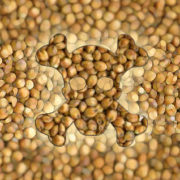How Plants Use Cyanide to Protect Themselves
Since plants are fixed in place and cannot move to elude their attackers, they have developed an elaborate array of chemical defenses to protect themselves from herbivores and pathogens. One way in which they defend themselves is through the production of toxic secondary metabolites. One group of these compounds is known as preformed inhibitors or phytoanticipins. They are present in an inactive form. A large subgroup of these molecules contain hydrogen cyanide (HCN) bound to a sugar molecule. These compounds are activated upon attack and poison the attacking organism by interfering with cellular respiration.
Many Plants Produce Cyanogenic Glucosides as Secondary Metabolites
As opposed to secondary metabolites that are induced after infection or attack by herbivores, preformed inhibitors are always present in a plant. They remain inactive, however, until their activation is triggered by the attack of an herbivore, such as an insect, or a pathogen. There are several classes of these compounds. One important class is the cyanogenic molecules—those that contain cyanide. Over 2650 species of plants contain HCN, ranging from ferns to common crop plants such as sorghum and cassava.
The cyanogenic compound is kept inactive by being conjugated to a sugar group. It is then known as a cyanogenic glucoside. This conjugation also allows the compound to be stored at high concentrations in the plant’s vacuole or in protein bodies. Enzymes called beta-glucosidases release the cyanogenic molecule. There are a number of different beta-glucosidase enzymes, specialized for specific cyanogenic glucosides.
This enzyme cleaves off the sugar molecule, releasing the compound that contains the cyanide. The beta-glucosidase is often stored in a separate compartment. It only encounters the molecule that contains the cyanide when the tissue is disrupted, such as by being chewed by an insect or animal. Once the beta-glucosidase is released from its compartment, it is able to react with the cyanogenic glucoside. This releases an unstable molecule, which then produces free HCN.
Food Crops Often Contain Cyanide
A large number of commonly grown food crops contain cyanogenic glucosides. It is thought that these secondary metabolites have been inadvertently bred into crops as natural pesticides to confer resistance against insects and other pests. Maize, wheat, rice, and barley all contain some level of cyanide in their leaves. With most food crops, there is little cyanide found in the parts of the plant eaten by humans.
An exception is the common crop cassava, the major staple food in many developing countries. This plant has such large amounts of cyanide in its roots they have to be specially treated to remove the cyanide for them to be safely edible. Cyanide poisoning from cassava is common enough to cause a condition of chronic paralysis known as konzo. Cassava plants have been genetically engineered to reduce cyanide production to ameliorate this problem. Humans are more likely to have problems detoxifying cyanide when their diet is low in protein, such as when it is cassava-based.
Biochemistry of Cyanogenic Glucoside Metabolism in Sorghum
The pathway of cyanide metabolism in cyanogenic plants is most thoroughly understood for sorghum and cassava. In sorghum, dhurrin is the cyanogenic glycoside that contains the HCN. It is located in the epidermal cells of the plant, while the beta-glucosidases that are specific for dhurrin are located in the chloroplasts. This separation of enzyme and substrate is referred to as compartmentalization. They do not meet unless the tissue is degraded.
A number of enzymes are involved in the synthesis of dhurrin, including two cytochrome P450s and a UDPG-glucosyltransferase. The biosynthetic compounds are organized as a group, so that the product of one enzyme can travel quickly to the next enzyme. Also, this reduces the chances of the plant being poisoned by the cyanogenic product. After tissue damage, the dhurrin is cleaved by a beta-glucosidase, releasing an alpha-hydroxynitrile compound.This is then cleaved enzymatically, releasing HCN.
The whole biosynthetic pathway has been transferred to the model plant Arabidopsis thaliana. These genetically engineered plants now possess the capability to produce cyanide and have an increased ability to deter flea beetles. This experiment provided definitive evidence that HCN production is a plant defense mechanism against herbivores.
References:
Jones, A.1998. Why are so many food plants cyanogenic? Phytochemistry 47:155-162
Morant, A.V., K. Jorgensen, C. Jorgensen, S.M. Paquette, R. Sanchez-Perez, B.L. Moller, S. Bak. 2008. B-glucosidases as detonators of plant chemical defense. Phytochemistry 69:1795-1813
Tattersall, D.B., S. Bak, P.R. Jones, C.E. Olsen, J.K.Nielsen, M.L. Hansen, P.B. Joh, R.L. Moller. 2001. Resistance to an herbivore through engineered cyanogenic glucoside synthesis. Science 293:1826-1828



